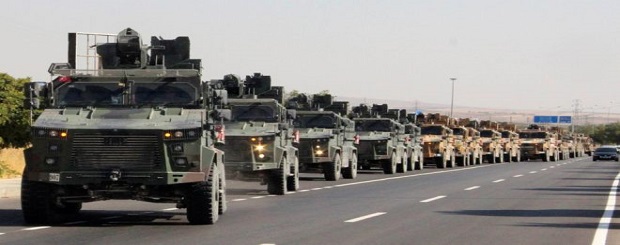
Turkish operation in Syria: what is happening and who will it affect? We explain in the cards
October 10, 2019 – ORIGINE SOURCES- // bbc.com/russian //
Before the US military had time to leave the Syrian areas on the border with Turkey, Ankara launched a military operation against the Kurds, traditionally inhabiting these territories in northeastern Syria.
Using detailed maps, we explain the progress of the operation and its possible consequences.
The war in Syria: Putin won, the West lost. A look from France
Why does Turkey’s invasion of Syria threaten a resurgence of the Islamic State?
Who are the Kurds?

Ethnic Kurds live in four countries – Iran, Iraq, Turkey and Syria.
In Syria, they make up 7-10% of the country’s population. For decades, they have been persecuted and infringed on the rights of the Syrian government. The Kurdish policy was especially tightened under the previous president of the country, Hafez Asad, and remained so under his son, Bashar Assad.
Before the beginning of the Arab spring of 2011, when the Syrians began to massively oppose the Assad regime, most Kurds lived in the large cities of Damascus and Aleppo, as well as in three areas bordering Turkey: in Afrin in the west, in central Koban and in Kamyshli in the east.
– What are the obstacles to Turkey’s Syrian Kurds?
– Erdogan – to the Kurds: proclaim independence – you will starve
When the Syrian protest escalated into a real civil war, the main Kurdish parties avoided taking sides.
In 2012, government forces fled Kurdish territory to concentrate on opposing rebels in other regions of the country. This allowed the Kurdish armed forces to take control of the border areas.
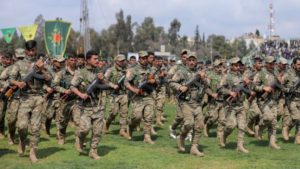
At the end of 2014, the Islamic State jihadist group (the organization is banned in Russia) attacked Kobani, then the international coalition led by the United States first resorted to air raids on the IS positions. The Islamists were driven back, and the Kurds became a key ally of the coalition in Syria.
In 2015, the Kurdish Popular Self-Defense Forces (YPG) became the basis for the creation of the Kurdish-Arab paramilitary alliance “Democratic Forces of Syria”.
With the support of an international coalition that supplied weapons, provided military training and supported the alliance from the air, its fighters pushed IS troops out of a quarter of Syria’s territory and in March 2019 took control of the last area held by the Islamists.
Why did Turkey need a military operation?
Turkish authorities have long warned of their intention to conduct a military operation against the “Democratic Forces of Syria” and create the so-called safe zone 480 kilometers long along the Syrian border and 32 kilometers wide deep into Syria.

Ankara wants to push Kurdish people’s self-defense units away from its borders, as they consider them a threat to their national security. According to Turkey, the troops are a militarized wing of the Kurdistan Workers’ Party (PKK), which has been against the Turkish state for decades and which has been recognized as a terrorist organization in Turkey.
In addition, more than 3.5 million Syrian refugees have accumulated in the border areas, and Ankara expects to resettle at least a million of them in order to reduce concentration in the immediate vicinity of its borders.
In an attempt to prevent a Turkish invasion, the United States in August of this year agreed to create a security system in the border areas together with the Turkish military. Kurdish units fulfilled their part of this agreement – they removed heavy guns from the districts and dismantled the fortifications.
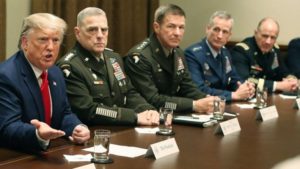
However, on October 6, Turkish President Rajep Tayyip Erdogan informed Donald Trump that the military operation would begin very soon. Trump replied that American troops stationed in the region would not take part in this from either side.
This response provoked fury among the Syrian Democratic Forces. The alliance warned that an unprovoked attack by Turkey would negatively affect its further struggle against the Islamic State and the relative stability that it was so difficult to establish in the region.
“We are committed to protecting our lands at all costs,” the alliance said in an official statement.
Presumably, the Turkish operation will be concentrated mainly on the 100-kilometer stretch of the border between the cities of Tell el Abyad and Ras al Ain.
What could be the consequences?
The territory that falls into the “safe zone” of Turkey is a fertile plain, which was formerly called the bread basket of Syria.

In contrast to the desert regions unsuitable for agriculture in the south of the country, this territory is dotted with dozens of cities and villages. The population of the city of Kamyshly, which partially remains under the control of government troops, amounted to 200 thousand people before the war.
According to the charity International Rescue Committee, currently in the areas controlled by the Democratic Forces of Syria, there are about 2 million people who have already survived the brutality of the Islamic State and were repeatedly driven out of their homes.
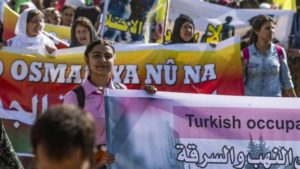
“A military operation can immediately lead to the resettlement of at least 300 thousand people and disrupt the work of humanitarian organizations, which is of vital importance to the local population,” the International Rescue Committee said a few days ago.
According to Save the Children, more than one and a half million civilians in the border region need humanitarian assistance. More than 650 thousand of them are internally displaced persons who fled from hostilities.
UN coordinator for the Syrian crisis, Panos Mumcis, said his agency has drawn up an emergency plan to help the civilian population in case people have to leave their homes because of the Turkish invasion.
According to him, the UN knows bitter examples when spaces with completely different goals were created under the personal “safe zones”. As an example, he cited the massacre in Srebrenica in 1995.
Prisoners of the IG fighters, their families and what will happen to them?
According to representatives of the Syrian Democratic Forces, under their control in seven prisons are more than 12 thousand men suspected of having links with the Islamic State. At least 4 thousand people are foreign nationals. Some prisons are located near the border with Turkey.
Families of prisoners are held in three camps for displaced persons – Rog, Ain Issa and Al Khol.
As of May 2019, the first two camps have 1,700 and 12,900 people, respectively. Both camps will be in the Turkish “safe zone”.

The third and largest camp, Al Khol, is located 60 kilometers from the border and does not fall into the zone. It contains more than 68 thousand people, of which 94% are women and children. 11 thousand inhabitants of the camp are citizens of other countries.
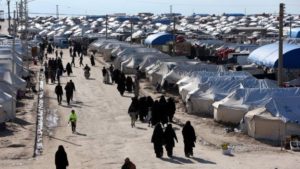
Donald Trump warned President Erdogan that Turkey would be responsible for the detained IS fighters who find themselves in territory controlled by it.
The Kurds say they are ready to continue guarding prisons and camps, but there is a danger that they themselves will have to flee from the Turkish invasion.
bbc.com/russian/features-50003943
